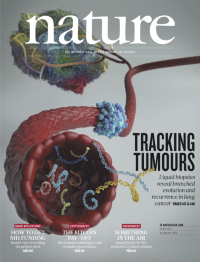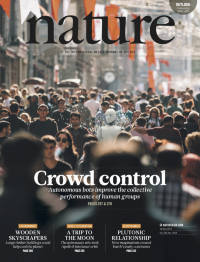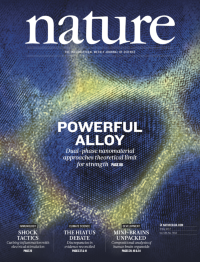Volume 545
-
No. 7655 25 May 2017
In this issue, Charles Swanton and his colleagues suggest that âliquid biopsiesâ could be used for the early detection of a relapse after surgery for non-small-cell lung cancer. The researchers assessed the evolutionary dynamics of tumours surgically removed from participants in the TRACERx lung-cancer clinical study. They created phylogenetic trees to show how an individualâs tumour evolved and used that information as the basis for a blood test to look for circulating tumour DNA (ctDNA). This allowed the team to identify recurrence of the tumour around 70 days before it was identified in a routine clinical setting as well as providing insight into the metastatic branched evolutionary process. The results indicate how liquid biopsies might be applied in personalized medicine to improve cancer monitoring. Cover image: Jeroen Claus and Giovanni Panico/Phospho Biomedical Animation.
Advertisement Feature
-
No. 7654 18 May 2017
A groupâs collective action towards a common goal, even if everyoneâs interests are aligned, faces a âcoordinationâ problem: an individualâs attempts to reach a solution that is optimal for him or her locally may not be optimal for the group as a whole. In this issue, Nicholas Christakis and Hirokazu Shirado demonstrate a potential solution to this problem in the shape of autonomous software (artificial intelligence) agents, or âbotsâ. They introduced simple bots into small networks of humans engaged in solving a standard colour coordination game â in which the collective goal is for every node to have a colour different from all of its neighbour nodes â thus creating a âheterogeneous systemâ of humans and bots. They found that using the bots to introduce noise into the decision-making process could improve the overall performance of the group. The noisy bots worked best when they were placed centrally in the network and they displayed moderate (10%) randomness. Under these conditions, the bots not only improved humanâbot interactions but also humanâhuman interactions at distant nodes, thereby helping humans to help themselves. Cover image: Cavan Huang
-
No. 7653 11 May 2017
The cover shows lipid bilayers in crystals of a calcium pump as revealed by X-ray solvent contrast modulation. Conventional X-ray crystallography cannot visualize membrane phospholipids, so structure analyses of membrane proteins usually have to pretend that no lipid bilayer exists. In this issue, Chikashi Toyoshima and colleagues reveal a crystallographic method using solvent contrast modulation that is able to include phospholipid head groups, signalling that future crystallography images no longer have to be fat-free. They deployed their technique on four states of a calcium pump, revealing for the first time how the lipid bilayer actively participates in the successive conformational switches of the pump. They were able to define a belt of tryptophan residues, which functions as a âmembrane floatâ, allowing the whole pump axis to tilt with respect to the membrane bilayer during ion transport, as well as arginine and lysine residues, which act as âmembrane anchorsâ and provide leverage for the helix movements. Credit: Yoshiyuki Norimatsu and Chikashi Toyoshima
Advertisement Feature
-
No. 7652 4 May 2017
The cover shows the microstructure of an exceptionally strong thin-film magnesium alloy captured using transmission electron microscopy. Produced by dual-phase nanostructuring, this alloy has a strength that approaches the ideal theoretical limit. Nanostructuring of crystalline metal alloys can yield high-strength materials, but these tend to soften as the strain is increased. In this latest work, Jian Lu and his team combine the benefits of nanocrystallinity with those of single-phase amorphous metallic glasses to yield a dual-phase material â MgCu2 nanocrystalline grains (6 nm) enclosed in an amorphous glassy shell (2 nm) â that resulted in the strongest thin-film magnesium alloy to be made so far. Cover image: Susanna Siu & Ge Wu/City University of Hong Kong
Advertisement Feature




